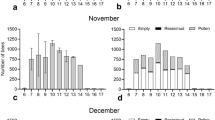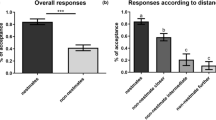Abstract
Experimental equipment has been developed to make possible continuous recordings of intensity distribution curves as a function of angle of incidence of light in single ommatidia of arthropod compound eyes. — As preliminary experiment, the visual fields of ommatidia in Limulus, Apis and Cataglyphis have been ascertained without a light measuring instrument. A point source was moved through the visual field and the angular position of the light source on both sides of the visual field at which the rhabdome in the cut-off eye viewed from proximal turned dark was determined. In the dorsal part of the Limulus eye, the cranio-caudal width of the visual field is 42.6±0.3°. The width of the visual field of central ommatidia in Apis is 6.68±0.14° in the dorsoventral plane and 7.42±0.24° in the cranio-caudal direction, in Cataglyphis 15.5±0.5° and 12.5±0.4° respectively.— Similar Gaussian curves for light and dark adapted ommatidia resulted from the continuous recordings of intensity distribution curves in Apis. The rotatory symmetric curve of the worker bee has a half-width of Δρ=2.57°. The standardized curve of amplitude one may be approximated by the function y=exp (-0.41 [degree−2]ϕ 2). In Cataglyphis, the half-width of the intensity distribution curve is Δρ=8.8° in the dorso-ventral plane and Δρ=6.8° in the cranio-caudal plane. Near the axis, the functions y=exp(-0.04 [degree−2]ϕ2) and y=exp(-0.06 [degree−2]ϕ 2) approximate the standardized curves. — Knowledge of intensity distributions in connection with interommatidial angles Δρ allows estimation of contrast transfer and resolving power of the array of the dioptric systems. Correlations with behavioural findings are attempted.
Similar content being viewed by others
Literatur
Autrum, H. J., Seibt, U.: Die Dunkeladaptation des Bienenauges. Naturwissenschaften 52, 566 (1965).
Autrum, H. J., Wiedemann, I.: Versuche über den Strahlengang im Insektenauge (Appositionsauge). Z. Naturforsch. 17b, 480–482 (1962).
Autrum, H. J., Zwehl, V. von: Die spektrale Empfindlichkeit einzelner Sehzellen des Bienenauges. Z. vergl. Physiol. 48, 357–384 (1964).
Barlow, H. B.: The size of ommatidia in apposition eyes. J. exp. Biol. 29, 667–674 (1952).
Baumann, F.: Slow and spike potentials recorded from retinula cells of the honeybee drone in response to light. J. gen. Physiol. 52, 855–875 (1968).
Braitenberg, V.: Patterns of projections in the visual system of the fly. I. Retina-lamina projections. Exp. Brain Bes. 3, 271–298 (1967).
Burkhardt, D., Streck, P.: Das Sehfeld einzelner Sehzellen — eine Richtigstellung. Z. vergl. Physiol. 51, 151–152 (1965).
Exner, S.: Die Physiologie der facettirten Augen von Krebsen und Insecten. Leipzig und Wien: Franz Deutioke 1891.
Fermi, G., Reichardt, W.: Optomotorische Reaktionen der Fliege Musca domestica. Kybernetik 2, 15–28 (1963).
Frisch, K. von: Der Farbensinn und Formensinn der Bienen. Zool. Jb. Abt. allg. Zool. und Physiol. 35, 1–182 (1915).
Giloi, W., Lauber, R.: Analogrechnen. Berlin-Göttingen-Heidelberg: Springer 1963.
Götz, K. G.: Optomotorische Untersuchung des visuellen Systems einiger Augenmutanten der Fruchtfliege Drosophila. Kybernetik 2, 77–92 (1964).
Götz, K. G.: Die optischen Übertragungseigenschaften der Komplexaugen von Drosophila. Kybernetik 2, 215–221 (1965).
Goldsmith, T. H.: Fine structure of the retinulae in the compound eye of the honey-bee. J. Cell Biol. 14, 489–494 (1962).
Goldsmith, T. H.: The course of light and dark adaptation in the compound eye of the honey-bee. Comp. Biochem. Physiol. 10, 227–237 (1963).
Horridge, G. A.: Unit studies on the retina of dragonflies. Z. vergl. Physiol. 62, 1–37 (1969).
Ioannides, A. C., Walcott, B.: Graded illumination potentials from retinula cell axons in the bug Lethocerus. Z. vergl. Physiol. 71, 315–325 (1971).
Kirschfeld, K.: Das anatomische und physiologische Sehfeld der Ommatidien im Komplexauge von Musca. Kybernetik 2, 249–257 (1965).
Kirschfeld, K.: Die Projektion der optischen Umwelt auf das Raster der Rhabdomere im Komplexauge von Musca. Exp. Brain Res. 3, 248–270 (1967).
Kirschfeld, K., Franceschini, N.: Ein Mechanismus zur Steuerung des Lichtflusses in den Rhabdomeren des Komplexauges von Musca. Kybernetik 6, 13–22 (1969).
Kirschfeld, K., Franceschini, N.: Optische Eigenschaften der Ommatidien im Komplexauge von Musca. Kybernetik 5, 47–52 (1968).
Kirschfeld, K., Reichardt, W.: Die Verarbeitung stationärer optischer Nachrichten im Komplexauge von Limulus. Kybernetik 2, 43–61 (1964).
Kuiper, J. W.: The optics of the compound eye. Symp. Soc. exp. Biol. 16, 58–71 (1962).
Kunze, P.: Untersuchung des Bewegungssehens fixiert fliegender Bienen. Z. vergl. Physiol. 44, 656–684 (1961).
Laughlin, S. B., Horridge, G. A.: Angular sensivity of retinula cells of dark-adapted worker bee. Z. vergl. Physiol. 74, 329–335 (1971).
McCann, G. D., MacGinitie, G. F.: Optomotor response studies of insect vision. Proc. roy. Soc. B 163, 369–401 (1965).
Menzel, R., Wehner, R.: Augenstrukturen bei verschieden großen Arbeiterinnen von Cataglyphis bicolor Fabr. (Formicidae, Hymenoptera). Z. vergl. Physiol. 68, 446–449 (1970).
Mote, M. I.: Electrical correlates of neural superposition in the eye of the fly Sarcophaga. J. exp. Zool. 175, 159–168 (1970).
Ohly, K. P.: Das Gesichtsfeld des Komplexauges der Honigbiene Apis mellifica. Diplomarbeit am Zoologischen Institut der Universität Frankfurt a. M., 1968.
Portillo, J. del: Beziehung zwischen den Oeffnungswinkeln der Ommatidien, Krümmung und Gestalt der Insektenaugen und ihrer funktionellen Aufgabe. Z. vergl. Physiol. 23, 100–145 (1936).
Reichardt, W.: Ueber das optische Auflösungsvermögen der Facettenaugen von Limulus. Kybernetik 1, 57–69 (1961).
Ruck, P. R.: A comparison of the electrical responses of compound eyes and dorsal ocelli in four insect species. J. Insect Physiol. 2, 261–274 (1958).
Sachs, L.: Statistische Auswertungsmethoden, 2. Aufl. Berlin-Göttingen-Heidelberg: Springer 1961.
Scholes, J.: The electrical responses of the retinal receptors and the lamina in the visual system of the fly Musca. Kybernetik 6, 149–162 (1969).
Seitz, G.: Der Strahlengang im Appositionsauge von Calliphora erythrocephala (Meig.). Z. vergl. Physiol. 59, 205–231 (1968).
Shaw, S. R.: Interreceptor coupling in ommatidia of drone honeybee and locust compound eyes. Vision Res. 9, 999–1029 (1969).
Tunstall, J., Horridge, G. A.: Electrophysiological investigation of the optics of the locust retina. Z. vergl. Physiol. 55, 167–182 (1967).
Varela, F. G.: Fine structure of the visual system of the honeybee (Apis mellifera). II. The lamina. J. Ultrastruct. Res. 31, 178–194 (1970).
Varela, F. G., Porter, K. R.: Fine structure of the visual system of the honeybee (Apis mellifera). I. The retina. J. Ultrastruct. Res. 29, 236–259 (1969).
Varela, F. G., Wiitanen, W.: The optics of the compound eye of the honeybee (Apis mellifera). J. gen. Physiol. 55, 336–358 (1970).
Vries, H. de: Physical aspects of sense organs. Progr. Biophys. 6, 207–264 (1956).
Vries, H. de, Kuiper, J. W.: Optics of the insect eye. Ann. N.Y. Acad. Sci. 74, 196–203 (1958).
Washizu, Y., Burkhardt, D., Streck, P.: Visual field of single retinula cells and interommatidial inclination hi the compound eye of the blowfly Calliphora erythrocephala. Z vergl. Physiol. 48, 413–428 (1964).
Waterman, T. H.: Directional sensitivity of single ommatidia in the compound eye of Limulus. Proc. nat. Acad. Sci. (Wash.) 40, 252–257 (1954).
Wehner, R., Eheim, W. P., Herrling, P. L.: Die Rastereigenschaften des Komplexauges von Cataglyphis bicolor (Formicidae, Hymenoptera). Rev. suisse Zool. Im Druck.
Wehner, R., Herrling, P. L., Brunnert, A., Klein, R.: Periphere Adaptation und zentralnervöse Umstimmung im optischen System von Cataglyphis bicolor (Formicidae, Hymenoptera). Rev. suisse Zool. Im Druck.
Wehner, R., Toggweiler, F.: Verhaltensphysiologischer Nachweis des Farbensehens bei Cataglyphis bicolor (Formicidae, Hymenoptera). Z. vergl. Physiol. Im Druck.
Wiedemann, I.: Versuche über den Strahlengang im Insekten- auge (Appositionsauge). Z. vergl. Physiol. 49, 526–542 (1965).
Wolf, E.: The visual intensity discrimination of the honey bee. J. gen. Physiol. 16, 407–422 (1933).
Wolf, E., Zerrahn-Wolf, G.: The dark adaptation of the eye of the honey bee. J. gen. Physiol. 19, 229–237 (1936).
Author information
Authors and Affiliations
Additional information
Mit Unterstützung durch den Schweizerischen National-fonds zur Förderung der wissenschaftlichen Forschung, Kredit Nr. 3.315.70, die Eidgenössische Konstruktionswerkstätte (Thun) sowie die Firmen Philips AG (Zürich) und Wild AG (Heerbrugg).
Rights and permissions
About this article
Cite this article
Eheim, W.P., Wehner, R. Die Sehfelder der zentralen Ommatidien in den Appositionsaugen von Apis mellifica und Cataglyphis bicolor (Apidae, Formicidae; Hymenoptera). Kybernetik 10, 168–179 (1972). https://doi.org/10.1007/BF00290516
Received:
Issue Date:
DOI: https://doi.org/10.1007/BF00290516




